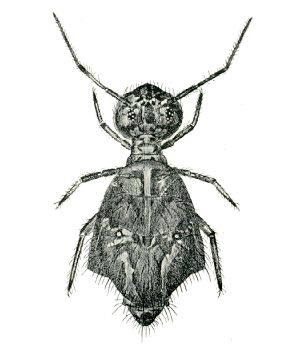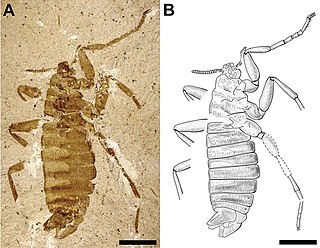
Flea, the common name for the order Siphonaptera, includes 2,500 species of small flightless insects that live as external parasites of mammals and birds. Fleas live by ingesting the blood of their hosts. Adult fleas grow to about 3 millimetres long, are usually brown, and have bodies that are "flattened" sideways or narrow, enabling them to move through their hosts' fur or feathers. They lack wings; their hind legs are extremely well adapted for jumping. Their claws keep them from being dislodged, and their mouthparts are adapted for piercing skin and sucking blood. They can leap 50 times their body length, a feat second only to jumps made by another group of insects, the superfamily of froghoppers. Flea larvae are worm-like, with no limbs; they have chewing mouthparts and feed on organic debris left on their hosts' skin.
Signiphoridae is a small family of parasitic wasps in the superfamily Chalcidoidea. The roughly 80 species are placed in four genera.

The burrowing parrot, also known as the burrowing parakeet or the Patagonian conure, is a species of parrot native to Argentina and Chile. It belongs to the monotypic genus Cyanoliseus, with four subspecies that are currently recognized.

Forensic entomology has three sub-fields: urban, stored product and medico-criminal entomologies. This article focuses on medico-criminal entomology and how DNA is analyzed with various blood-feeding insects.

The human flea – once also called the house flea – is a cosmopolitan flea species that has, in spite of the common name, a wide host spectrum. It is one of six species in the genus Pulex; the other five are all confined to the Nearctic and Neotropical realms. The species is thought to have originated in South America, where its original host may have been the guinea pig or peccary.

The Diplostraca or Cladocera, commonly known as water fleas, are a superorder of small crustaceans that feed on microscopic chunks of organic matter.

Sminthuridae is a family of springtails of the order Symphypleona. Sminthurids are commonly referred to as globular springtails.

The dog flea is a species of flea that lives as an ectoparasite on a wide variety of mammals, particularly the domestic dog and cat. It closely resembles the cat flea, Ctenocephalides felis, which can live on a wider range of animals and is generally more prevalent worldwide.

Xenopsylla is a flea genus in the family Pulicidae.

The Pulicidae are a flea family in the order Siphonaptera. Currently, this family has 181 species in 27 genera. Of these, 16 are known from North America.
The Pulicinae form a flea subfamily in the family Pulicidae.

The Xenopsyllinae form a flea subfamily in the family Pulicidae.

The beaver beetle is an ectoparasitic beetle that is only found on its host species, beavers, and the sole member of the genus Platypsyllus. It is flattened and eyeless, resembling a flea or tick. It used to be placed in a separate family called Leptinidae, but is now placed in the family Leiodidae, in the subfamily Platypsyllinae.
Spilopsyllus cuniculi, the rabbit flea, is a species of flea in the family Pulicidae. It is an external parasite of rabbits and hares and is occasionally found on cats and dogs and also certain seabirds that nest in burrows. It can act as a vector for the virus that causes the rabbit disease myxomatosis.

Zigrasimecia is an extinct genus of ants which existed in the Cretaceous period approximately 98 million years ago. The first specimens were collected from Burmese amber in Kachin State, 100 kilometres (62 mi) west of Myitkyina town in Myanmar. In 2013, palaeoentomologists Phillip Barden and David Grimaldi published a paper describing and naming Zigrasimecia tonsora. They described a dealate female with unusual features, notably the highly specialized mandibles. Other features include large ocelli, short scapes, 12 antennomeres, small eyes, and a clypeal margin that has a row of peg-like denticles. The genus Zigrasimecia was originally incertae sedis within Formicidae until a second species, Zigrasimecia ferox, was described in 2014, leading to its placement in the subfamily Sphecomyrminae. Later, it was considered to belong to the distinct subfamily Zigrasimeciinae.

Siphonophorida is an order of millipedes containing two families and over 100 species.

Heteromysis is a genus of marine mysid crustaceans from the family Mysidae, associated with various shallow-water invertebrates. The name describes differentiation of its pereiopods as possible adaptation to commensal life-style. Heteromysis is one of the largest mysid genera, containing more than 100 species. The genus is distributed globally, but predominantly in tropical and subtropical waters.
Hectopsylla is a genus of fleas in the family Hectopsyllidae that parasitize non-volant mammals, birds, and bats. The genus comprises thirteen species, six of which were described in whole or part by Karl Jordan between 1906–1942. Two of the species in Hectopsylla, H. psittaci and H. pulex, go under common names, with H. psittaci identified as the sticktight flea and H. pulex identified as the chiggerflea. Hastritter and Méndez (2000) consider the genus Rhynchopsyllus a junior system of the genus.

Hypoborus ficus, the fig bark beetle, is a species of weevil found in many European, Mediterranean and Asian countries.

Pseudopulicidae is an extinct family of stem-group fleas from the Middle Jurassic to Early Cretaceous of China. They represent the oldest known group of stem-fleas. Like other stem-group "giant fleas", they are much larger and lack the specialised morphology of modern fleas.














